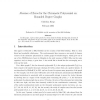7 search results - page 1 / 2 » Absence of Zeros for the Chromatic Polynomial on Bounded Deg... |
CPC
2006
13 years 5 months ago
2006
ALGORITHMICA
2004
13 years 4 months ago
2004
We consider the Chromatic Sum Problem on bipartite graphs which appears to be much harder than the classical Chromatic Number Problem. We prove that the Chromatic Sum Problem is NP...
JCT
2007
13 years 4 months ago
2007
Let P(G,t) and F(G,t) denote the chromatic and flow polynomials of a graph G. D.R. Woodall has shown that, if G is a plane triangulation, then the only zeros of P(G,t) in (−∞...
CPC
2007
13 years 4 months ago
2007
Let P(G,t) and F(G,t) denote the chromatic and flow polynomials of a graph G. G.D. Birkhoff and D.C. Lewis showed that, if G is a plane near triangulation, then the only zeros of...
JGT
2008
13 years 4 months ago
2008
A homomorphism from an oriented graph G to an oriented graph H is a mapping from the set of vertices of G to the set of vertices of H such that ----(u)(v) is an arc in H whenever...

